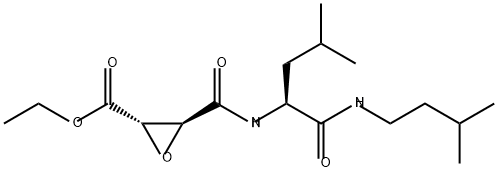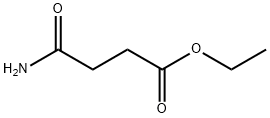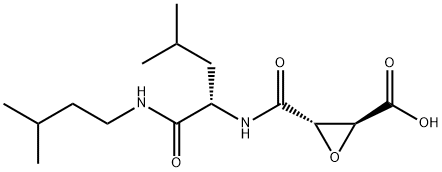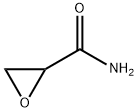EST
Synonym(s):EST;Loxistatin, (2S,3S)- trans-Epoxysuccinyl-L-leucylamido-3-methylbutane Ethyl Ester, E-64d;Loxistatin, (2S,3S)-trans-Epoxysuccinyl-L-leucylamido-3-methylbutane Ethyl Ester, E-64d;MAP3K8;TPL2
- CAS NO.:88321-09-9
- Empirical Formula: C17H30N2O5
- Molecular Weight: 342.43
- MDL number: MFCD00132883
- SAFETY DATA SHEET (SDS)
- Update Date: 2024-11-11 17:44:06

What is EST?
Description
E-64d is an irreversible, membrane-permeable inhibitor of lysosomal and cytosolic cysteine proteases and has diverse biological activities. It is a synthetic analog of E-64 and prodrug form of E-64c that inhibits calpain and the cysteine proteases cathepsins F, -K, -B, -H, and -L. E-64d (20-200 μM) induces cell cycle arrest at the G2/M phase in A431 human epidermoid carcinoma cells. It inhibits protease-resistant prion protein accumulation in scrapie-infected neuroblastoma cells with an IC50 value of 0.5 μM. E-46d also inhibits entry of vesicular stomatitis virus (VSV) particles pseudotyped with severe acute respiratory syndrome coronavirus (SARS-CoV) or SARS-CoV-2 spike glycoprotein into Vero cells, an effect that is reduced by expression of the serine protease TMPRSS2.
The Uses of EST
E-64d is an inhibitor of cathepsins B and L as well as a potential inhibitor of calpain. E-64d has been shown to inhibit lysosomal proteases. E-64d has been used in combination with Prepstatin A to in terfere with autolysosomal digestion. E-64d displays neurovascular and neuronal protective effects after focal cerebral ischemia in rats.
The Uses of EST
E-64d is an inhibitor of cathepsins B and L as well as a potential inhibitor of calpain. E-64d has been shown to inhibit lysosomal proteases. E-64d has been used in combination with Prepstatin A to interfere with autolysosomal digestion. E-64d displays neurovascular and neuronal protective effects after focal cerebral ischemia in rats.
The Uses of EST
E-64d has been used as a lysosomal inhibitor in human acute promyelocytic leukemia NB4 cells and Huh-7?cells. It has also been used as a protease inhibitor in free calcium physiological tyrode solution for perfusion into the isolated heart samples.
What are the applications of Application
E-64-d is a potent lysosome and cell permeable inhibitor of thiol protease and cathepsin B, H, and L.
Definition
ChEBI: An L-leucine derivative that is the amide obtained by formal condensation of the carboxy group of (2S,3S)-3-(ethoxycarbonyl)oxirane-2-carboxylic acid with the amino group of N-(3-methylb tyl)-L-leucinamide.
Biochem/physiol Actions
E-64d is an epoxysuccinyl peptide and an inhibitor of cysteine protease cathepsin B, calpains 1 and 2. E-64d by its cathepsin B protease inhibition functionality, may serve as a potential drug for treating traumatic brain injury (TBI) and Alzheimer′s disease (AD). It inhibits gametocyte surface antigen resulting in a decreased oocyst production in Plasmodium falciparum.
Safety Profile
Moderately toxic by intraperitoneal route. An experimental teratogen. Experimental reproductive effects. Mutation data reported. Whenheated to decomposition it emits toxic fumes of NOx.
storage
Store at -20°C
References
1) McGowan?et al.?(1989),?Inhibition of calpain in intact platelets by the thiol protease inhibitor E-64d; Biochem. Biophys. Res. Commun.,?158?432 2) Wilcox and Mason (1992),?Inhibition of cysteine proteinases in lysosomes and whole cells; Biochem. J.,?285?495 3) Mizushima?et al.?(2010), Methods in mammalian autophagy research; Cell,?140?313
Properties of EST
| Melting point: | 126.2°C |
| Boiling point: | 477.88°C (rough estimate) |
| Density | 1.0657 (rough estimate) |
| refractive index | 1.5800 (estimate) |
| storage temp. | -20°C |
| solubility | Soluble in DMSO, DMF or ethanol |
| form | White solid |
| pka | 13.32±0.40(Predicted) |
| color | Fine needles from EtOH |
| Stability: | Stable for 1 year from date of purchase as supplied. Solutions in DMSO or ethanol may be stored at -20°C for up to 1 month. |
Safety information for EST
| Signal word | Warning |
| Pictogram(s) |
 Exclamation Mark Irritant GHS07 |
| GHS Hazard Statements |
H315:Skin corrosion/irritation H319:Serious eye damage/eye irritation H335:Specific target organ toxicity, single exposure;Respiratory tract irritation |
| Precautionary Statement Codes |
P261:Avoid breathing dust/fume/gas/mist/vapours/spray. P304+P340:IF INHALED: Remove victim to fresh air and Keep at rest in a position comfortable for breathing. P305+P351+P338:IF IN EYES: Rinse cautiously with water for several minutes. Remove contact lenses, if present and easy to do. Continuerinsing. P405:Store locked up. |
Computed Descriptors for EST
New Products
4-Fluorophenylacetic acid 4-Methylphenylacetic acid N-Boc-D-alaninol N-BOC-D/L-ALANINOL Tert-butyl bis(2-chloroethyl)carbamate 3-Morpholino-1-(4-nitrophenyl)-5,6-dihydropyridin- 2(1H)-one Furan-2,5-Dicarboxylic Acid Tropic acid S-2-CHLORO PROPIONIC ACID ETHYL ISOCYANOACETATE 2-Bromo-1,3-Bis(Dimethylamino)Trimethinium Hexafluorophosphate (6-METHYL-[1,3]DITHIOLO[4,5-b]QUINOXALIN-2-ONE INDAZOLE-3-CARBOXYLIC ACID 4-IODO BENZOIC ACID (2-Hydroxyphenyl)acetonitrile 4-Bromopyrazole 5,6-Dimethoxyindanone 2-(Cyanocyclohexyl)acetic acid 4-methoxy-3,5-dinitropyridine 2-aminopropyl benzoate hydrochloride 1-(4-(aminomethyl)benzyl)urea hydrochloride diethyl 2-(2-((tertbutoxycarbonyl)amino) ethyl)malonate tert-butyl 4- (ureidomethyl)benzylcarbamate Ethyl-2-chloro((4-methoxyphenyl)hydrazono)acetateRelated products of tetrahydrofuran








You may like
-
![E-64d [for Biochemical Research] CAS 88321-09-9](https://img.chemicalbook.in//Content/image/CP5.jpg) E-64d [for Biochemical Research] CAS 88321-09-9View Details
E-64d [for Biochemical Research] CAS 88321-09-9View Details
88321-09-9 -
 COT (30-397), active, GST tagged human CASView Details
COT (30-397), active, GST tagged human CASView Details -
 E-64d CAS 88321-09-9View Details
E-64d CAS 88321-09-9View Details
88321-09-9 -
 EST CAS 88321-09-9View Details
EST CAS 88321-09-9View Details
88321-09-9 -
 1975-50-4 98%View Details
1975-50-4 98%View Details
1975-50-4 -
 2-HYDROXY BENZYL ALCOHOL 98%View Details
2-HYDROXY BENZYL ALCOHOL 98%View Details
90-01-7 -
 14714-50-2 (2-Hydroxyphenyl)acetonitrile 98+View Details
14714-50-2 (2-Hydroxyphenyl)acetonitrile 98+View Details
14714-50-2 -
 118753-70-1 98+View Details
118753-70-1 98+View Details
118753-70-1